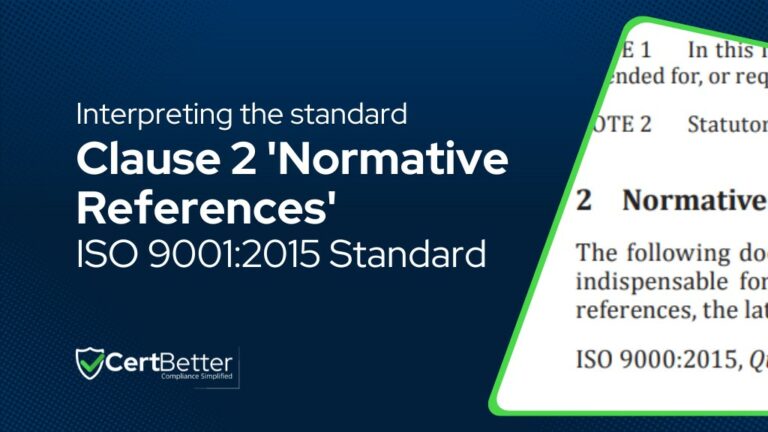Clause 2 Normative References of ISO 9001 2015 Explained With Examples

Once you understand Clause 1 Scope of the ISO 9001:2015 standard, Clause 2 seems another challenge to overcome but it’s very simple. Normative References are like the ‘vocabulary’ section of a book. It points to the ISO 9000 standard, which is like a dictionary for quality management. This dictionary explains all the important terms and basic ideas that you need to understand ISO 9001 properly.
This clause of the standard makes sure everyone is on the same page about what specific terms mean in the world of quality management. This helps avoid confusion and makes it easier for organizations to follow the standard correctly.
What does Normative Reference mean?
Like I mentioned above, a normative reference means it’s an ISO terms and jargons dictionary that provides necessary context, requirements or definitions that are integral to understanding and implementing the main ISO standard document. Compliance with the main document often requires adherence to these normative references.
Why are Normative References Important?
Imagine trying to put together a complicated piece of furniture without knowing what the instructions mean. It would be pretty tough, right? Similarly, without normative references, interpreting and applying ISO 9001:2015 could become inconsistent and confusing.
This shared vocabulary and set of concepts ensure that when organizations around the world apply ISO 9001:2015, they’re all working from the same understanding.
Clause 2 Normative references in the context of ISO 9001:2015 are established references that the standard builds upon, providing a solid base for understanding and implementing the rest of the content.
These references are documents that are essential for the application of the standard. In the case of ISO 9001:2015, the primary normative reference is ISO 9000, which lays out the fundamentals and vocabulary for quality management systems.
Examples of Normative References
Once you understand the meaning of normative references, the next bit is to look for specific reference documents. Here’s some examples:
ISO 9000 – Provides fundamental concepts, principles, and vocabulary related to quality management systems.
ISO 19011 – Offers guidelines for auditing management systems, useful for internal audits and supplier evaluations.
ISO 10012 – Focuses on measurement management systems, ensuring metrological requirements are met.
These references support the implementation and understanding of ISO 9001 requirements.
How to use Clause 2 Normative References?
To effectively integrate Clause 2 into your ISO 9001:2015 certification process strategy, start by thoroughly familiarizing yourself with ISO 9000 (I know it sounds odd!). This document is key to understanding the fundamental concepts and terminology essential for quality management. Here are some tips and best practices:
Thorough Familiarization with ISO 9000 — Start by ensuring that key personnel, especially those involved in quality management, are thoroughly familiar with ISO 9000. Understanding the fundamental concepts and definitions it contains is crucial for a coherent approach to quality management.
Consistent Use of Terminology — Use the standardized terms and definitions from ISO 9000 across all your documentation, training, and communication. This consistency helps prevent misunderstandings and ensures everyone in your organization is on the same page.
Training and Awareness — Regular training sessions can help staff at all levels understand the concepts and vocabulary of ISO 9000. This awareness is vital for implementing the principles effectively in daily operations.
Integration into QMS Documentation — When developing or updating your QMS documentation, refer back to the definitions and principles in ISO 9000. This ensures that your QMS aligns with the standards and is easily understood by internal and external auditors.
Aligning Business Processes — Ensure that your business processes reflect the principles and definitions from ISO 9000. This alignment will help in maintaining a process-driven approach, which is a key aspect of ISO 9001:2015 Quality Management System.
Ongoing Review and Improvement — Regularly review your QMS and its practices against the guidance in ISO 9000. This not only aids in compliance but also drives continual improvement.
By implementing these practices, you can ensure that Clause 2 of ISO 9001:2015 is not just a reference point but a practical tool that enhances the effectiveness and coherence of your quality management efforts.
Common Questions
What does ISO 9000 cover?
ISO 9000 provides the fundamentals and vocabulary for quality management systems.
Is ISO 9000 necessary for implementing ISO 9001:2015?
Yes, it’s essential for understanding the terms and principles upon which ISO 9001:2015 is built.
How does Clause 2 affect a Quality Management System?
It provides the foundational terminology and concepts, ensuring a consistent approach to quality management.
Can misunderstanding Clause 2 impact compliance?
Yes, misinterpreting it can lead to incorrect application of the standard’s principles.
Are there crucial terms in ISO 9000 for understanding Clause 2?
Key terms include ‘quality’, ‘management system’, and ‘customer satisfaction’.
Does Clause 2 change the approach for those already ISO 9001 certified?
For those certified under earlier versions, it emphasizes the need to align with the updated terminology and concepts in ISO 9000:2015.
Final Thoughts
My recommendation is to purchase a copy of ISO 9000:2015, Quality management systems — Fundamentals and vocabulary and regularly revisit it to keep your quality management practices aligned with the standard. This will not only aid in maintaining compliance with ISO 9001:2015 but also ensure continual improvement and consistency in your quality management efforts. Integrating Clause 2 is about building a solid base of understanding that supports the entire quality management structure.
- Last updated: June 29, 2024
- CertBetter
Our community of compliance professionals and ISO experts is ready to provide you with insightful answers and practical solutions. Join the discussion now!
- Recommended Reads
- 36 reads
-
Frequently Asked Questions
Understanding ISO Terminology: Guide to Important Terms and Concepts
No posts found
ResetConnect with ISO Certification Consultants
CertBetter makes it easy to find ISO certification consultants and compliance professionals from around the globe.

